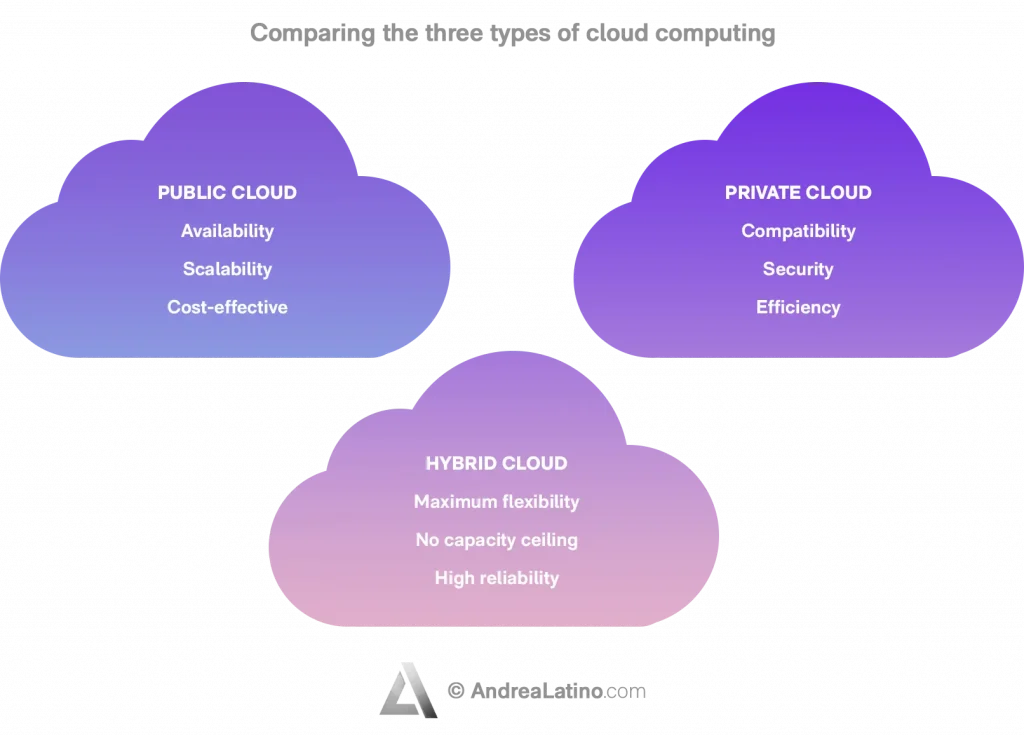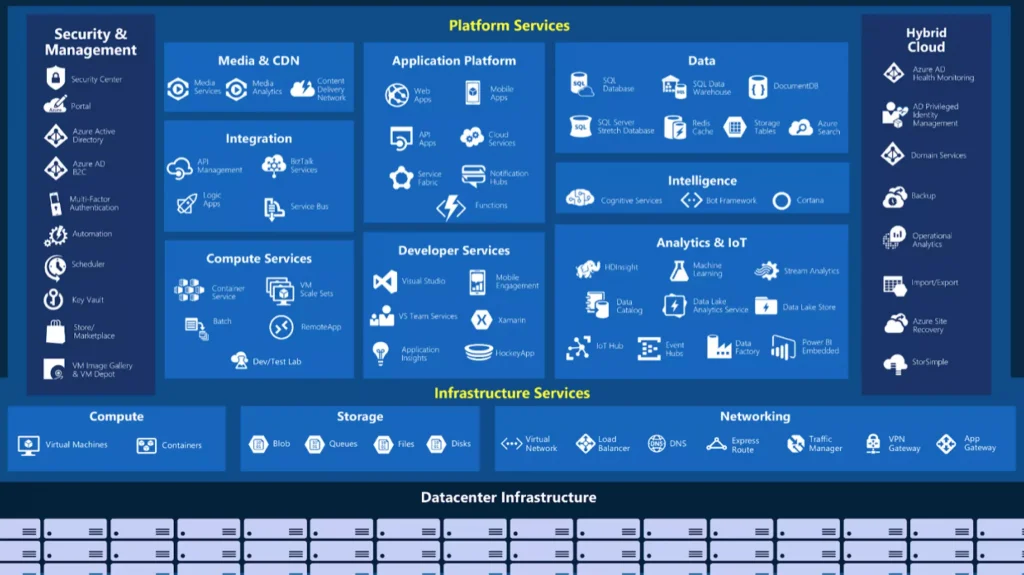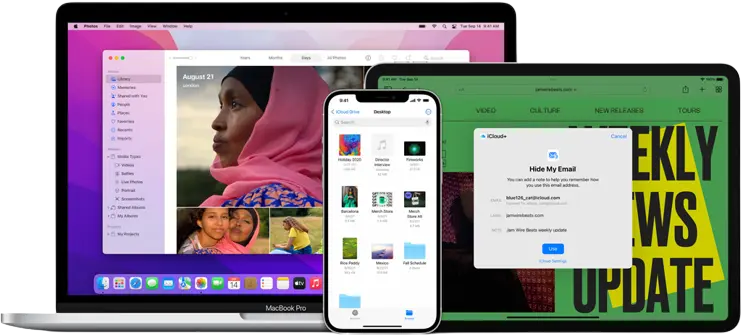Innovation Alphabet
Cloud Computing
In a nutshell
Cloud Computing is an on-demand technology service provider that is anything but “cloudy”. All you need is an internet connection, and you can access a platform that offers computing, storage and database capabilities based on your needs. Cloud Computing could be private, public or hybrid, but it will always offer faster innovation, flexible resources, and economies of scale.


definitions
• Private Cloud
In the private cloud, Cloud Computing resources are used exclusively by a single organization or company, which manages the available space as it sees fit. The private cloud may reside in the enterprise data center, under the control of internal staff, or it may be outsourced to a specialized external provider.
• Public Cloud
The infrastructure is owned by the service provider. It delivers services available to the public via the Internet on resources shared by multiple users. The provider supports infrastructure investments. The customer pays on a pay-as-you-go basis only for the services they actually use.
• Hybrid Cloud
Hybrid Cloud, as you can imagine, is a middle ground between the clouds listed above. Such an environment allows the enterprise to move data and applications between public and private clouds, thus offering greater flexibility and more deployment options.

Application Fields
• Infrastructure-as-a-Service (IaaS): The cloud provider leases an infrastructure complete with all the necessary resources. The customer can freely access and manage it independently, paying according to consumption.
• Structure-as-a-Service (SaaS): It is a model for the distribution of software accessible to the user via the Internet. The provider hosts and manages applications and takes care of maintenance activities.
• Platform-as-a-Service (PaaS): The provider offers the company an “all-inclusive” platform where it can develop its applications quickly and easily, without having to worry about the technical implications related to the underlying infrastructure. This is the most efficient solution, since it does not require engaging in any kind of onerous activity related to application execution.
Industries
• Cloud Computing for Amazon Web Services (AWS)
Among the many services Amazon delivers is Cloud. Amazon’s platform offers more than 175 Cloud Computing services. It goes from compute, storage, and database infrastructure to new technologies such as machine learning, artificial intelligence, data lake, analytics and IoT. AWS supports 90 security standards and compliance certificates. All 117 AWS services that store customer data offer the ability to encrypt that data.
• Cloud Computing for Microsoft Azure
This is a public Cloud Computing platform. It provides a range of cloud services, including computing, analytics, storage, and networking. Users can choose from more than 200 cloud products and services designed to develop new solutions or run existing applications in the public cloud. The platform offers tools that support all industries, including finance and e-commerce. It is also compatible with open-source technologies. Ninety-five percent of Fortune 500 companies (the 500 largest U.S. corporate enterprises measured by their revenue) entrust their business to Azure.

• Cloud Computing for iCloud
It is the service offered by Apple that allows content to be automatically stored and disseminated to all available iOS products. It allows automatic synchronization of data, contacts, passwords, pictures, and music tracks among the user’s various devices. In this way, when a change is made on one of the devices, all others are updated instantaneously.

Do you have a Strategy & Innovation challenge to tackle? Let’s face it. Together.
C-levels from these companies (AND MORE) relied on my expertise to overcome thEIR CHALLENGES IN THIS AREA. And you can, too.
Can I help you?Business Functions
• Cloud Computing in support of maintenance
By embracing Big Data, Analytics and Cloud Computing in collaboration with SAP (a German software company), NOVA Chemicals has improved its maintenance planning processes. Through the cloud-based software, stakeholders have a daily and/or weekly view of scheduled work, priorities, and resources needed. This makes it easier to execute work and control material availability. The change introduced has reduced the number of plant outages and increased time spent on proactive and preventive maintenance by 61 percent.
• Cloud Computing in support of customer experience
IBM addressed American Airlines’ immediate and long-term operational concerns through a migration from on-premises software to IBM Cloud Infrastructure-as-a-Service with the VMware Cloud Foundation solution.
• Cloud Computing in support of time-to-market
To make operations more efficient, foster greater innovation, and launch new features and products to market faster, UBank wanted to implement a PaaS solution. As a result, the company adopted an IBM Cloud platform on which to propose new initiatives. There’s also a virtual assistant that incorporates IBM Watson technology to support the bank’s online mortgage application.
Stay in wonderland
Let me show you how deep the rabbit hole goes.
Check out more of the Innovation Alphabet:

3D Printing
3D Printing
“3D printing” is a process carried out by an electronic device which, instead of resorting to the canonical ink, it molds almost any kind of material: from concrete to living tissue, most usually plastic, but also metal. And the operating principle is similar to that of a traditional printer. The creation of three-dimensional models can lead to the redesign of a company’s production capabilities.
Dive In
5G
5G
5G is the new frontier of cellular telephony. It was designed to improve (or completely replace) previous generations of mobile networks. The 5th generation features lower latency, ensuring flawless performance of business applications and many other digital experiences – thus enabling the new cultural generations to furiously play Fortnite away from home.
Dive In
Advanced Analytics
Advanced Analytics
The term “Advanced Analytics” refers to the ability to autonomously or semi-autonomously analyze data and content to identify correlations, develop analyses, predictions, and recommendations. It is not just a matter of collecting information and then organizing it into watertight compartments: the ultimate goal is to identify a dialogue pattern from a data-driven perspective.
Dive In
Agile
Agile
Agile is an approach to software development designed to respond to change. Teams quickly analyze the context in which they operate, identify uncertainties faced, and figure out how to adapt to always move forward. Interaction between individuals comes before processes and tools; collaboration with the customer is more important than negotiating contracts.
Dive In
Ansoff Matrix
Ansoff Matrix
The Ansoff Matrix is a marketing planning model that arises from the intersection of new and existing products and markets. It derives four possible strategies for expanding the company’s market, which are built around four variables with a changeable factor of risks and possibilities: existing product, new product, existing market, new market.
Dive In
Artificial Intelligence
Artificial Intelligence
Artificial Intelligence is not strictly defined. Basically, it is a computer system able to make decisions in an independent and flexible way. A good AI application can perform everyday tasks better than an average person (e.g., identifying other people from their photos on social media or beating the best chess player). Nothing to fear, then. Unless you are a chess champion.
Dive In
Artificial Scarcity
Artificial Scarcity
We often tend to desire what we cannot have. Or what we are in danger of losing: Artificial Scarcity is a strategy that flaunts a limited number of items that do not correspond to actual availability. The goal is to stimulate the perception in consumers that the stock of items is about to run out and thus create a need based on the “fear of being cut off” or the intention to buy the item in order to resell it at a higher price.
Dive In
Attack Surface
Attack Surface
The term attack surface refers to the part of a system that may be subject to attack or breach by hackers. The smaller that surface is, the easier it will be to protect it. Indeed, the Internet is an ocean of deep, dark waters: those who navigate it must be aware that they are exposing themselves to a flood of digital risks. Yet, ironically, we do not need a big boat to shelter us.
Dive In
Augmented Reality
Augmented Reality
Augmented Reality is an ever-evolving technology that overlays multimedia information on top of our common sensory horizon to gain a deeper understanding of our surroundings. No, it doesn’t allow you to step out of the Matrix dream simulation, nor can it be accessed by swallowing a red pill. But neither is it the disturbing experience of the Playtest episode of Black Mirror.
Dive In
Balanced Scorecard
Balanced Scorecard
In business, as in life, you need balance. The Balanced Scorecard is a holistic tool for strategic management. It offers, in fact, the possibility of assessing corporate performance in its wholeness. An overview that embraces four perspectives: the business/financial side, customers and stakeholders, internal processes, and learning and growth.
Dive In